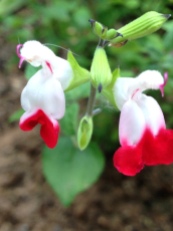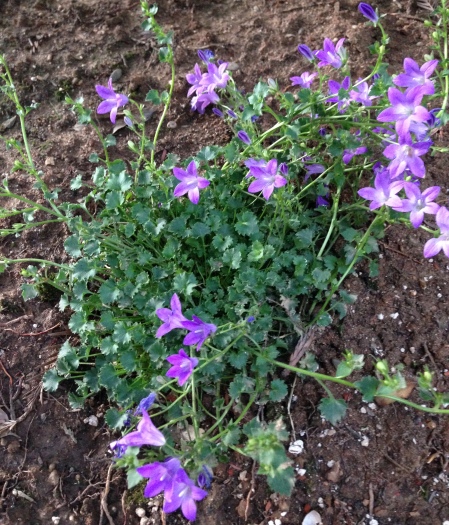That you are sure to find something in the genus Salvia to delight your soul and your senses! The diversity of this family of plants offers year-round interest with colorful flowers, dramatic foliage, fragrance and a welcoming hug for bees, butterflies and hummingbirds.
The natural habitats of over 900 cultivars of salvia are spread all over the globe with hundreds originating in Mexico, Central and South America alone. You may choose tender annuals to fill those garden spots needing a burst of color or hardy perennials which will reward you year after year demanding very little attention. While many are rugged, unthirsty performers which will stand up to long, hot summers there are also many tender family members requiring shade and a more moist environment. All salvias are not created equal and that is truly a plus for us in the garden world. A little education will help you find the right ones to meet your garden needs. I count The Plant Lover’s Guide to Salvias by John Whittlesey as an invaluable resource. In addition, California is home to a variety of nursery operations whose enthusiasm for salvias is evident in both the varieties they have for sale and their breeding efforts. The Digging Dog Nursery in Albion and Annie’s Annuals in Richmond are worthy of a visit. Flowers by the Sea in Elk has a comprehensive mail order catalog. Check them out at http://www.fbts.com and be sure to look at their blog Everything Salvias.
Since any post covering all the salvias I would like to introduce you to would have to be book length I am going to focus today on a group called by academically minded plantsmen “the greggii microphylla complex”. This is a confusing group of species which includes Salvia greggii, S. microphylla, S. x jamensis (a naturally occurring hybrid of the first two) and several others. There are many series of cultivars bred from various combinations of these species. A few examples found recently in my retail haunts include selections from the Heatwave, Mesa and Western Dancer series. These names commonly appear as part of the cultivar name although whether they are marked as greggii or microphylla is somewhat less consistent from grower to grower. These are not the showiest nor most refined members of their clan but, in general, plants in this complex are hardy, rugged perennials with twiggy stems, small fragrant leaves with their flowers held slightly above the foliage on slender stems. Salvia ‘Mesa Azure’ was my introduction to these shrubby salvias when I dug in a few 4″ pots in for color in the spring of 2010. I added ‘Mesa Rose’ and ‘Mesa Purple’ to my southern exposure front garden at the same time but ‘Mesa Azure’ remains my enduring favorite. Just by luck of the draw the other two colors ended up in a bed now dominated by a 20′ tall Raywood Ash (planted as a 15 gallon tree in 2010) and have lost most of their sun. They are still lovely but flower somewhat less vigorously than ‘Mesa Azure’ which has grown in full sun with minimal water for lo these many years and only gets better every year. I force it to rest most years by trimming it back in late November. In mild winters it has burst back into bloom by late January and blooms on and on. The flowers are more purple than the name would suggest and they they tend to open a lighter lavender then age to a bit darker hue.Likewise new foliage is a lighter, brighter green before it hardens off a bit. Pictured below is the most mature of the Salvia ‘Mesa Azure’ plants I adore and two photos showing the interesting flower color variation.

The plants in this greggii/microphylla umbrella vary in flower color and somewhat in mature height. The ‘Mesa Azure’ is a bit less than knee height, receiving a bit of tidying up now and then to reduce its twiggyness and promote new growth. Plants tags generally list heights as being 24″-36″. This year I have added many new plants from this complex to my garden and only time will tell in terms of their mature height and hardiness. Just today I bought Salvia ‘Maraschino’ and its tag lists 36′ to 8′—now that is a pretty wide range! I am going to give this new one a bit of afternoon shade per my internet research. Toward the end of the summer I’ll report back to you how my new residents have faired. As the foliage is not spectacular on any of this group I have tried to give you a peek at the variety of flower colors available. See some of my new friends below. Remember to roll your cursor over the photo for the cultivar’s name.
A little note–there are several S. greggii/microphylla cultivars in the light yellow, apricot and orange color ranges but all y’all know I just don’t do orange. There are also several pale and medium blues on my acquisition list.
Just to wet your appetite for Sage Advice part 2 I’ll leave with with a few additional photos of salvias to desire–quite different from today’s group! Can you identify any of these?



































































